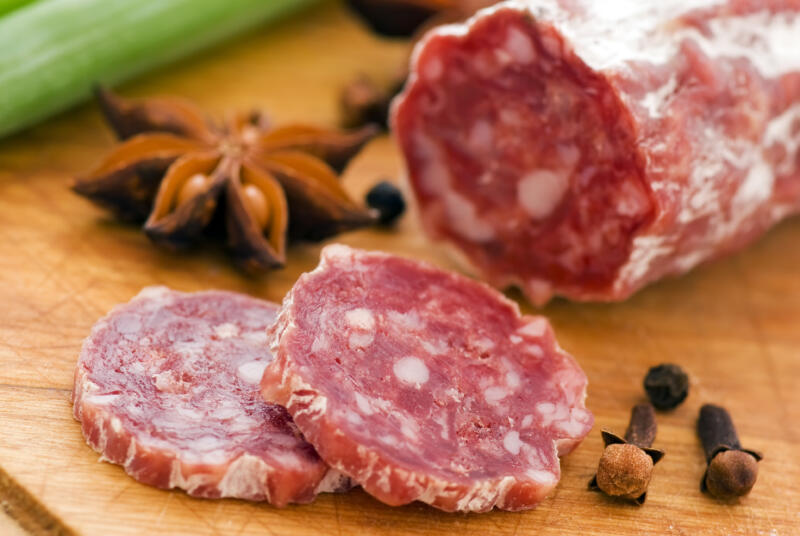As food lover, I’ve often found myself in the great “Salami vs. Pepperoni” debate. At first glance, they’re like two peas in a pod – or should I say, two meats on a pizza? But don’t let your eyes fool you!

Despite their striking resemblance, these two cured meats have their own unique tales to tell. In this article, we’ll slice right into the heart of the matter, uncovering the distinct characteristics that set salami and pepperoni apart.
In this article:
Comparing Salami and Pepperoni
When it comes to the culinary world, the devil is often in the details.
This is particularly true when comparing similar foods like salami and pepperoni. While they may seem interchangeable at first glance, a closer look reveals a world of differences in taste, texture, ingredients, and nutritional content.

Let’s delve into these differences to better understand what sets these two popular cured meats apart.
1. Taste
The taste comparison between salami and pepperoni is where their differences truly shine. Pepperoni is typically saltier and spicier than salami, with a distinct smokiness that adds depth to its flavor profile.
This is due to the generous use of spices like paprika and chili pepper during its preparation.
On the other hand, salami, while also flavorful, is often less spicy. It comes in a variety of flavors, from mild to spicy, depending on the specific type and the blend of spices used.
2. Texture
Texture is another area where pepperoni and salami differ significantly. Pepperoni typically has a firmer texture with a slightly chewy consistency, which becomes even more pronounced when it’s cooked, as it often is on pizza.
Salami, in contrast, can have a softer texture with a more tender, melt-in-your-mouth feel.
This is especially true for certain varieties of salami that have a coarser texture, providing a different sensory experience compared to the smoothness of pepperoni.
3. Ingredients
The ingredients used in salami and pepperoni also differ, contributing to their unique taste and texture profiles.
Both are made from a combination of pork and beef, but the specific proportions and the types of additional ingredients used vary.
Pepperoni is typically seasoned with spices like paprika and chili pepper, which lends it a distinctive fiery kick.
In contrast, the seasoning used in salami can vary significantly. It often includes a flavorful blend of garlic, black pepper, white pepper, nutmeg, coriander, and fennel.
However, the exact mix can differ based on the type of salami and regional variations, resulting in a unique taste profile for each variety.
Additionally, different curing agents are used in the preparation of these two meats, further distinguishing their flavors.
4. Nutritional Comparison
Pepperoni and salami are high in protein, but they also contain significant amounts of fat, cholesterol and sodium.
The fermentation process used in their production can affect their nutrient composition, often increasing their sodium content.
When comparing equal serving sizes, pepperoni tends to have a higher salt content.
A 1-ounce serving of pepperoni contains about 530 milligrams of salt, while the same serving size of salami contains approximately 401 milligrams of salt.
While neither pepperoni nor salami are particularly healthy due to their high fat and sodium content, some types of salami may be slightly healthier due to leaner cuts of meat and fewer additives.
As with any food, moderation is key when enjoying these delicious cured meats.
Pepperoni and Salami in Cooking

Pepperoni and salami are not just for pizza toppings; they can be versatile ingredients in a variety of dishes.
Their unique flavors can enhance and transform simple recipes into gourmet delights.
For instance, salami and ricotta bruschetta is a delightful appetizer that combines the savory taste of salami with the creamy texture of ricotta cheese.
Pepperoni lasagna roll-ups offer a fun twist on the traditional lasagna, with the spiciness of pepperoni adding an extra kick.
And of course, salami and pepperoni pizza is a classic favorite, combining the best of both worlds for a truly indulgent treat.

When cooking with pepperoni and salami, don’t be afraid to experiment.
Try crisping the slices on a skillet before adding them to your dish for added texture.
Marinate the sausages in garlic and spices for extra flavor.
Or, for a deliciously cheesy pizza, top your dough with both salami and pepperoni along with generous amounts of mozzarella cheese.
The possibilities are endless when it comes to cooking with these flavorful meats.
Health Risks Associated with Consuming Pepperoni and Salami
The health risks associated with consuming pepperoni and salami are primarily due to their high calorie, fat, and sodium content.
Frequent consumption of these processed meats can lead to weight gain, high blood pressure, and heart disease.
Additionally, the nitrites and nitrates used in their processing can potentially increase the risk of certain types of cancer.
Some people may also experience digestive problems or allergic reactions due to the chemicals and fillers commonly found in processed meats.
As with any food, moderation is key when enjoying pepperoni and salami.
Cultural Significance and Usage
Pepperoni and salami hold significant cultural value in their respective countries of origin and have been widely adopted in various cuisines around the world.
Salami, with its roots in Italy, is a symbol of the country’s rich culinary tradition.
It’s used in a variety of traditional dishes, from antipasto platters to sandwiches, and has been incorporated into modern recipes as well.
Conversely, pepperoni is an American twist on traditional salami.
Despite its relatively recent invention in the early 20th century, it has quickly become a staple in American cuisine, particularly in pizza.
Its popularity has spread globally, with pepperoni pizza being a favorite in many countries.
Popular Brands and Varieties

Whether you prefer the classic Italian salami or the American-style pepperoni, there’s a brand and variety out there to satisfy your taste buds, cooking needs, and dietary concerns.
Pepperoni Brands
Notable pepperoni brands you might recognize are Hormel, Bridgford, and Boar’s Head.
These brands offer pepperoni that is well-known for its consistent quality, spiciness, and smoky flavor.
Hormel: Known for its consistent quality, spiciness, and smoky flavor.
Bridgford: Offers a well-regarded pepperoni.
Boar’s Head: Their pepperoni is popular and they also offer a well-rated hard salami
Salami Brands
When it comes to salami, brands like Genoa, Milano, Fiorucci and Columbus are often recognized for their quality products.
These brands offer a range of salami varieties, from the mild and delicate to the bold and spicy.
Genoa: A recognized brand for quality salami products.
Milano: Offers a range of salami varieties.
Columbus: Their Italian Dry Salame stands out for its pronounced pepper zest complemented by a subtle garlic undertone. The inclusion of red wine gives it a unique, slightly tangy taste.
Boar’s Head: Their Sliced Hard Salami is praised for its proper amount of fat and strong pork flavor.
Foustman’s: Hailing from California’s Bay Area, this family-run venture is renowned for its handcrafted salami.
Applegate: Their Genoa Salami, uncured and sumptuous, offers a melt-in-your-mouth experience. Enhanced with the robustness of garlic and pepper, it strikes a delightful balance of saltiness and zest.
Fiorucci: Their Uncured Sliced Hard Salami is indulgently rich, offering a genuine pork flavor that stands out, rather than a questionable blend of meats. It’s truly a savory delight.
Oscar Mayer: Their Hard Salami offers a delightful smoky and salty taste. While it might not top the charts compared to other salamis listed here, its flavor holds its own among pre-sliced varieties, all at an attractive price point.
Trader Joe’s: They offer Salame Di Parma Mild Salami and Chianti Red Wine Artisan Salami, both of which have received positive reviews.
Please note that the quality and taste of these products can vary based on personal preference and the specific product line from each brand.
Closing Thoughts
While both pepperoni and salami are types of cured sausages and are often used interchangeably, they each have their own unique characteristics that set them apart.
I encourage you to experiment with these delicious cured meats in your cooking.
Try them in different recipes, play around with flavors, and discover your own favorite ways to enjoy them.
And remember, food is all about personal preference and enjoyment, so there’s no right or wrong choice between salami and pepperoni.
If you have any questions or comments, or if you’d like to share your own experiences with these two delightful meats, please feel free to leave a comment below.